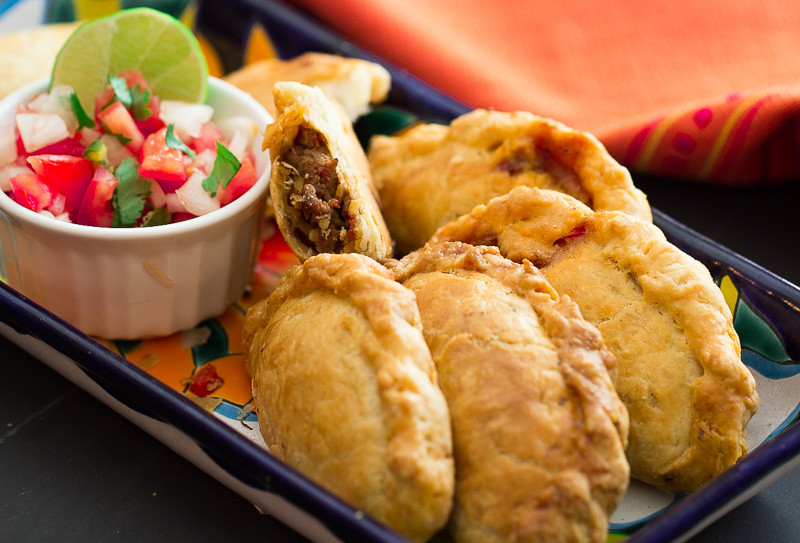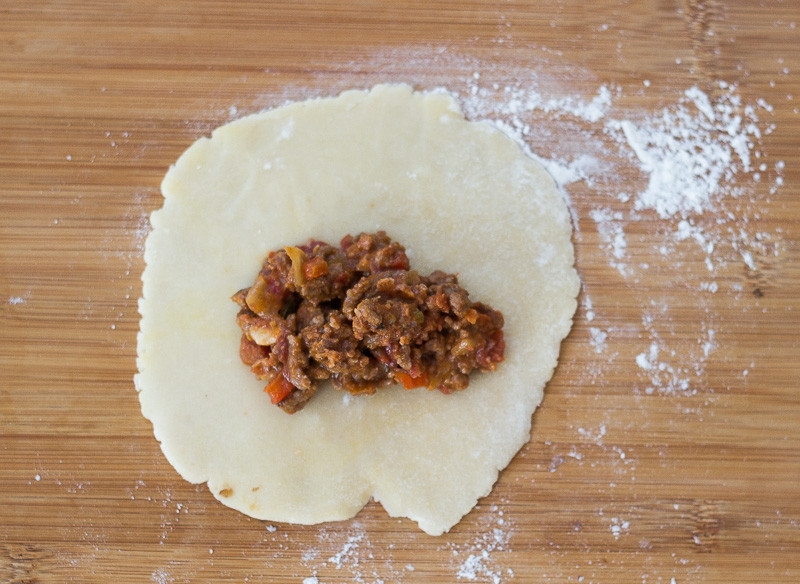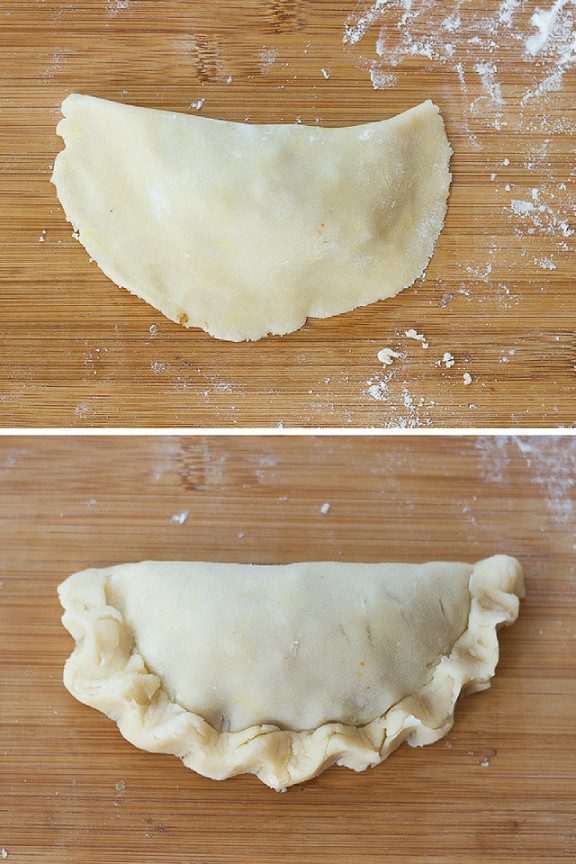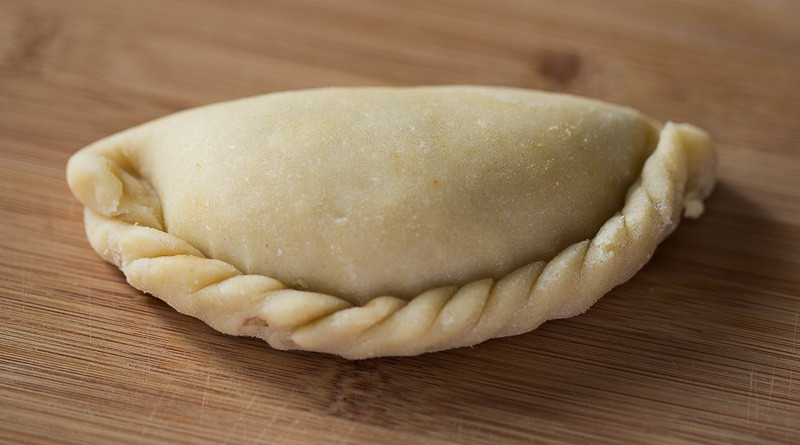Empanadas are indeed Mexican, offering a savory and delightful experience! Join us on gaymexico.net as we explore the flavorful world of Mexican empanadas, a perfect culinary adventure for LGBTQ+ travelers seeking authentic cultural experiences in Mexico. Discover where to find the best empanadas and their significance in Mexican gastronomy. Enjoy a taste of Mexico with open arms and a full heart!
1. What Exactly Are Empanadas?
Empanadas are small, savory pastries filled with a variety of ingredients, offering a delightful culinary experience. These are essentially stuffed bread or pastry, baked or fried. Empanadas are prevalent in Latin American and Spanish cuisines, with each region boasting its own unique variations. The dough is typically made from wheat flour, although corn flour can also be used, especially in some Latin American countries. These are versatile and can be filled with almost anything, from meats and cheeses to vegetables and fruits.
Empanadas have a rich history, dating back to medieval Spain, where they were influenced by Arab cuisine. The name “empanada” comes from the Spanish verb “empanar,” meaning “to wrap or coat in bread.” From Spain, these delectable pastries spread throughout Latin America, adapting to local ingredients and culinary traditions.
2. Are Empanadas Considered Mexican Food?
Yes, empanadas are absolutely considered Mexican food and are a beloved part of the country’s diverse culinary landscape. While they originated in Spain, Mexico has embraced and adapted empanadas, creating unique regional variations that reflect local flavors and ingredients. Mexican empanadas often feature fillings like seasoned meats, cheeses, and vegetables, infused with traditional Mexican spices and herbs.
Empanadas in Mexico are not just a food item; they are a cultural staple, often enjoyed during celebrations, festivals, and family gatherings. They represent a blend of culinary traditions, showcasing Mexico’s ability to adopt and transform dishes from other cultures into something distinctly its own. Street vendors, local markets, and restaurants all across Mexico proudly offer their versions of empanadas, making them easily accessible and a must-try for anyone visiting the country. For LGBTQ+ travelers exploring Mexico, trying empanadas is a delicious way to connect with the local culture.
3. What Are the Most Popular Types of Mexican Empanadas?
Mexican empanadas come in a delightful variety, each showcasing the country’s diverse regional flavors and culinary traditions. Here are some of the most popular types:
- Empanadas de Picadillo: Filled with a savory mixture of ground meat (usually beef or pork) seasoned with tomatoes, onions, garlic, raisins, and olives. This is a classic and widely loved filling.
- Empanadas de Pollo: These are stuffed with shredded chicken, often cooked with tomatoes, onions, and chili peppers. The chicken filling is flavorful and comforting, making it a popular choice.
- Empanadas de Queso: Simple yet satisfying, these are filled with cheese, typically Oaxaca cheese or a similar melting cheese. Sometimes, they include additions like jalapeños for a bit of heat.
- Empanadas de Rajas con Queso: Featuring roasted poblano peppers (rajas) and cheese, these empanadas have a mild heat and a creamy, cheesy filling.
- Empanadas de Frijol con Queso: Filled with refried beans and cheese, these are a hearty and vegetarian-friendly option.
- Empanadas de Frutas: Sweet empanadas filled with fruits like apple, pineapple, or pumpkin. These are often enjoyed as a dessert or sweet snack.
Each type of empanada offers a unique taste experience, reflecting the culinary diversity of Mexico. Whether you prefer savory or sweet, there’s an empanada to suit every palate.
4. What Ingredients Are Typically Found in Mexican Empanadas?
Mexican empanadas boast a rich array of ingredients that contribute to their unique and vibrant flavors. The most common ingredients include:
- Dough: The dough is typically made from wheat flour, water, and fat (such as lard or vegetable shortening). Some recipes may also include eggs for a richer texture.
- Meat: Beef, pork, and chicken are popular choices for savory empanadas. The meat is usually ground or shredded and seasoned with various spices and herbs.
- Cheese: Queso Oaxaca, queso fresco, and other melting cheeses are frequently used to add a creamy and savory element.
- Vegetables: Onions, garlic, bell peppers, tomatoes, and chili peppers are commonly used to enhance the flavor of the fillings.
- Spices and Herbs: Cumin, Mexican oregano, chili powder, and cilantro are often used to season the fillings, giving them a distinctive Mexican flavor.
- Fruits: Apples, pineapples, and pumpkin are used in sweet empanadas, often combined with sugar, cinnamon, and other spices.
These ingredients can vary depending on the region and the specific type of empanada, but they all contribute to the delicious and diverse flavors of Mexican empanadas.
5. What Is the History of Empanadas in Mexico?
The history of empanadas in Mexico is a tale of cultural exchange and culinary adaptation. Empanadas were introduced to Mexico by the Spanish during the colonial period, beginning in the 16th century. The Spanish brought with them their culinary traditions, including the empanada, which quickly became integrated into Mexican cuisine.
Over time, Mexicans adapted the empanada to suit local tastes and available ingredients. Traditional Spanish fillings were replaced or augmented with native Mexican ingredients such as chili peppers, tomatoes, and various local spices. This adaptation led to the creation of distinctly Mexican empanadas, with regional variations that reflect the diverse culinary landscape of the country.
Today, empanadas are a beloved and ubiquitous part of Mexican cuisine, enjoyed throughout the country. They are a testament to Mexico’s ability to blend foreign influences with its own rich culinary heritage, creating dishes that are both familiar and uniquely Mexican.
6. How Are Empanadas Typically Made in Mexico?
Making empanadas in Mexico is a process that combines traditional techniques with local flavors. Here’s a general overview of how they are typically made:
- Dough Preparation:
- The dough is usually made from wheat flour, water, and fat (such as lard or vegetable shortening).
- The ingredients are mixed together to form a smooth dough, which is then rested to allow the gluten to relax.
- Filling Preparation:
- The filling varies depending on the type of empanada but typically includes meat, cheese, vegetables, or fruits.
- For savory fillings, meat is often cooked with onions, garlic, and various spices. Vegetables are sautéed to soften them and enhance their flavor.
- For sweet fillings, fruits are cooked with sugar and spices until they soften and create a jam-like consistency.
- Assembly:
- Small portions of dough are rolled out into circles.
- A spoonful of filling is placed in the center of each dough circle.
- The dough is folded in half to form a semi-circle, and the edges are sealed by pressing them together with fingers or a fork.
- Cooking:
- Empanadas can be baked or fried.
- Baked empanadas are brushed with an egg wash to give them a golden-brown color. They are then baked in a preheated oven until the crust is cooked through and golden brown.
- Fried empanadas are cooked in hot oil until they are golden brown and crispy.
The specific steps and ingredients can vary depending on the region and the type of empanada being made, but this is the general process for making these delicious pastries in Mexico.
7. What Are Some Regional Variations of Empanadas in Mexico?
Mexico’s diverse culinary landscape gives rise to numerous regional variations of empanadas, each with its unique flavors and ingredients. Here are some notable examples:
- Oaxaca: Known for empanadas filled with quesillo (Oaxaca cheese) and flor de calabaza (squash blossoms). The cheese is stringy and melts beautifully, while the squash blossoms add a delicate, floral flavor.
- Veracruz: Offers empanadas filled with minilla, a flavorful fish stew made with tomatoes, onions, and olives. The filling is savory and slightly tangy, reflecting the coastal influence.
- Chiapas: Features empanadas filled with chipilín, a local herb with a distinctive flavor, often combined with cheese or chicken. The chipilín adds an earthy and slightly bitter note to the empanadas.
- Yucatán: Showcases empanadas filled with cochinita pibil, slow-roasted pork marinated in achiote paste and citrus juices. The pork is tender and flavorful, with a hint of sweetness and spice.
- Guanajuato: Popular for empanadas filled with cajeta, a caramelized goat’s milk caramel. These sweet empanadas are a delicious dessert or snack.
These regional variations highlight the culinary richness of Mexico, with each area putting its unique spin on the classic empanada. For LGBTQ+ travelers exploring Mexico, sampling these regional specialties is a fantastic way to experience the country’s diverse food culture.
8. Where Can You Find the Best Empanadas in Mexico?
Finding the best empanadas in Mexico is an adventure in itself, as every region and even every cook has their own unique twist on this classic dish. Here are some tips on where to look:
- Local Markets (Mercados): Markets are a great place to find authentic, homemade empanadas. Vendors often sell freshly made empanadas with a variety of fillings.
- Street Food Stalls: Keep an eye out for street food vendors, especially in the evenings. Many of them specialize in empanadas, offering a quick and delicious snack.
- Small, Family-Owned Restaurants (Fondas): These eateries often serve traditional Mexican dishes, including empanadas made with time-honored recipes.
- Regional Specialties: If you’re traveling to a specific region, ask locals for recommendations on the best place to try their local empanada variation.
- Bakeries (Panaderías): Many bakeries offer empanadas, both savory and sweet, as part of their daily selection.
By exploring these options, you’re sure to discover some truly delicious and authentic empanadas during your travels in Mexico.
9. Are Empanadas a Popular Street Food in Mexico?
Yes, empanadas are indeed a very popular street food in Mexico, offering a convenient and delicious option for locals and tourists alike. You’ll find empanada vendors on nearly every street corner, especially in busy urban areas and during festivals.
Empanadas are favored as street food because they are easy to eat on the go, come in a variety of flavors, and are relatively inexpensive. Whether you’re looking for a quick lunch, a mid-afternoon snack, or a late-night bite, empanadas are a readily available and satisfying choice. Their popularity among street food options makes them a must-try for anyone exploring Mexican cuisine.
10. How Do Mexicans Typically Eat Empanadas?
Mexicans typically enjoy empanadas as a quick and satisfying snack or meal, often eaten with their hands. They are commonly served warm, either freshly baked or fried, and can be enjoyed at any time of the day.
Empanadas are often paired with a variety of salsas, depending on the filling and personal preference. A tangy salsa verde (green salsa) or a spicy salsa roja (red salsa) can add an extra layer of flavor. Some people also enjoy empanadas with a dollop of crema (Mexican sour cream) or guacamole.
Empanadas are versatile and can be eaten as a standalone snack or as part of a larger meal. They are a staple at family gatherings, festivals, and celebrations, reflecting their importance in Mexican culinary culture.
11. Can Empanadas Be Made Vegetarian or Vegan?
Yes, empanadas can absolutely be made vegetarian or vegan, offering delicious options for those with dietary restrictions. Vegetarian empanadas often feature fillings like cheese, vegetables, beans, or a combination of these. Popular vegetarian fillings include:
- Queso (Cheese): Simple cheese empanadas are a classic vegetarian option.
- Rajas con Queso: Roasted poblano peppers with cheese provide a mild heat and creamy texture.
- Frijoles con Queso: Refried beans with cheese make for a hearty and satisfying filling.
- Vegetales (Vegetables): A mix of sautéed vegetables like corn, zucchini, and bell peppers can create a flavorful vegetarian empanada.
Vegan empanadas can be made by using plant-based dough and fillings. Common vegan fillings include:
- Frijoles (Beans): Refried beans or black beans seasoned with spices.
- Vegetales (Vegetables): A variety of sautéed or roasted vegetables.
- Hongos (Mushrooms): Mushrooms cooked with onions and garlic.
- Papa (Potato): Potatoes cooked with onions and spices.
To make the dough vegan, use vegetable shortening or oil instead of lard. With a little creativity, it’s easy to create delicious and satisfying vegetarian or vegan empanadas that everyone can enjoy.
12. What Are Some Popular Sauces or Accompaniments for Empanadas?
Empanadas in Mexico are often enjoyed with a variety of sauces and accompaniments that enhance their flavors. Here are some popular choices:
- Salsa Verde: A green sauce made from tomatillos, chili peppers, onions, cilantro, and lime juice. Its tangy and slightly spicy flavor pairs well with savory empanadas.
- Salsa Roja: A red sauce made from tomatoes, chili peppers, onions, garlic, and spices. It can range from mild to very spicy, depending on the type of chili peppers used.
- Crema Mexicana: A Mexican sour cream that is thinner and slightly tangier than American sour cream. It adds a creamy and cooling element to the empanadas.
- Guacamole: A dip made from avocados, tomatoes, onions, cilantro, lime juice, and chili peppers. Its rich and creamy texture complements the savory fillings of empanadas.
- Pico de Gallo: A fresh salsa made from chopped tomatoes, onions, cilantro, jalapeños, and lime juice. Its bright and fresh flavors add a refreshing contrast to the empanadas.
- Pickled Jalapeños: Sliced jalapeños pickled in vinegar, carrots, and onions. They provide a spicy and tangy kick.
These sauces and accompaniments allow you to customize the flavor of your empanadas and add an extra layer of deliciousness to your dining experience.
13. Are There Sweet Versions of Empanadas in Mexico?
Yes, there are indeed sweet versions of empanadas in Mexico, offering a delightful contrast to the savory varieties. These sweet empanadas are often enjoyed as a dessert or a sweet snack and are filled with a variety of fruits, sweet creams, or other sweet ingredients. Some popular sweet empanada fillings include:
- Manzana (Apple): Apples cooked with sugar, cinnamon, and other spices, similar to apple pie filling.
- Piña (Pineapple): Pineapple cooked with sugar and spices, creating a sweet and tangy filling.
- Calabaza (Pumpkin): Pumpkin puree cooked with sugar, cinnamon, and other spices, often enjoyed during the fall season.
- Cajeta: A caramelized goat’s milk caramel that is rich and sweet.
- Dulce de Leche: A sweet caramel made from condensed milk, similar to cajeta but made with cow’s milk.
These sweet empanadas are a delicious way to end a meal or to enjoy as a treat, showcasing the versatility of the empanada in Mexican cuisine.
14. How Do Empanadas Vary From Region to Region in Mexico?
Empanadas in Mexico vary significantly from region to region, reflecting the diverse culinary traditions and available ingredients across the country. These variations can be seen in the fillings, dough, and cooking methods used.
- Fillings:
- Coastal regions often feature seafood fillings, such as shrimp, fish, or seafood stews.
- Inland regions tend to use more meat-based fillings, like pork, beef, or chicken.
- Vegetarian options are more common in areas with a strong tradition of vegetable farming.
- Sweet fillings vary widely, with different regions using local fruits and sweeteners.
- Dough:
- Some regions use wheat flour dough, while others prefer corn flour dough.
- The dough can be thin and flaky or thicker and more bread-like, depending on the regional preference.
- Cooking Methods:
- Some regions prefer baking empanadas, while others favor frying them.
- The cooking method can affect the texture and flavor of the empanada, with baked empanadas being lighter and less greasy than fried ones.
These regional variations make exploring empanadas in Mexico a culinary adventure, with each region offering a unique and delicious experience.
15. Can You Find Empanadas at Mexican Restaurants in the USA?
Yes, you can often find empanadas at Mexican restaurants in the USA, especially in areas with large Mexican-American populations. Mexican restaurants in the USA often serve empanadas as appetizers, side dishes, or even main courses, offering a taste of Mexican cuisine to their customers.
The types of empanadas available at Mexican restaurants in the USA can vary, but some common options include:
- Picadillo: Ground meat with tomatoes, onions, and spices.
- Pollo (Chicken): Shredded chicken with vegetables and spices.
- Queso (Cheese): Simple cheese empanadas.
- Rajas con Queso: Roasted poblano peppers with cheese.
In addition to these traditional fillings, some restaurants may offer their own unique creations, blending Mexican flavors with American tastes. Whether you’re looking for a classic empanada or a modern twist on this traditional dish, you’re likely to find it at a Mexican restaurant in the USA.
16. How Are Empanadas Different in Mexico Compared to Other Latin American Countries?
While empanadas are popular throughout Latin America, there are distinct differences in how they are made and enjoyed in Mexico compared to other countries. These differences often reflect the local ingredients, culinary traditions, and cultural preferences of each region.
- Fillings:
- In Argentina, empanadas often feature beef fillings with olives, eggs, and potatoes.
- In Chile, seafood fillings like shrimp and crab are common.
- In Colombia, empanadas are often made with corn flour dough and filled with meat, potatoes, and spices.
- In Mexico, empanadas showcase a wide variety of fillings, including picadillo, chicken, cheese, and vegetables, often seasoned with chili peppers and Mexican spices.
- Dough:
- Argentina and Chile typically use wheat flour dough.
- Colombia often uses corn flour dough.
- Mexico uses both wheat flour and corn flour dough, depending on the region and the type of empanada.
- Spices:
- Each country uses its own unique blend of spices, reflecting local flavors.
- Mexico is known for using chili peppers, cumin, and Mexican oregano in its empanadas.
- Sweet vs. Savory:
- While most Latin American countries focus on savory empanadas, Mexico has a significant tradition of sweet empanadas filled with fruits and sweet creams.
These differences highlight the culinary diversity of Latin America, with each country putting its own unique spin on the classic empanada.
17. What Cultural Significance Do Empanadas Hold in Mexico?
Empanadas hold significant cultural importance in Mexico, representing a blend of culinary traditions and a symbol of Mexican hospitality and community. They are more than just a food item; they are a cultural staple enjoyed during celebrations, festivals, and family gatherings.
- Celebrations and Festivals:
- Empanadas are often served during holidays like Día de Muertos (Day of the Dead), Christmas, and Independence Day.
- They are a popular food item at local fairs and festivals, where vendors sell a variety of empanadas with different fillings.
- Family Gatherings:
- Empanadas are a common dish at family gatherings, where they are made from scratch and shared among loved ones.
- Making empanadas together is often a family tradition, passed down from generation to generation.
- Symbol of Hospitality:
- Offering empanadas to guests is a sign of hospitality and welcome in Mexican culture.
- They are a convenient and delicious food item to share with friends and family.
- Reflection of Regional Identity:
- The regional variations of empanadas reflect the diverse culinary landscape of Mexico, with each region putting its unique spin on this classic dish.
- Empanadas are a way for Mexicans to connect with their regional identity and culinary heritage.
Empanadas, therefore, are deeply embedded in the cultural fabric of Mexico, representing a rich blend of history, tradition, and community.
18. Are Empanadas a Popular Dish Among the LGBTQ+ Community in Mexico?
Yes, empanadas are a popular and widely enjoyed dish among the LGBTQ+ community in Mexico, just as they are among the general population. Food is a universal pleasure, and empanadas, with their diverse fillings and flavors, are enjoyed by people of all backgrounds and orientations.
The LGBTQ+ community in Mexico, like any other community, enjoys a wide variety of foods, and empanadas are a common and accessible option. Whether they are homemade, bought from street vendors, or enjoyed at restaurants, empanadas are a delicious and convenient choice for a quick snack or a meal. The diversity of fillings available also means that there is an empanada to suit every taste preference, making them a popular choice for everyone.
19. What Are Some Tips for Making Empanadas at Home?
Making empanadas at home can be a fun and rewarding culinary experience. Here are some tips to help you create delicious empanadas:
- Dough:
- Use cold ingredients (butter and water) to make a flaky dough.
- Don’t overwork the dough, as this can make it tough.
- Rest the dough in the refrigerator for at least 30 minutes before rolling it out.
- Filling:
- Make sure the filling is not too wet, as this can make the dough soggy.
- Cool the filling completely before assembling the empanadas.
- Season the filling well to enhance its flavor.
- Assembly:
- Roll out the dough thinly and evenly.
- Use a cookie cutter or a round object to create uniform circles.
- Don’t overfill the empanadas, as this can make them difficult to seal.
- Seal the edges tightly by pressing them together with your fingers or a fork.
- Cooking:
- Brush the empanadas with an egg wash for a golden-brown color.
- Bake or fry the empanadas until they are cooked through and golden brown.
- Serve the empanadas warm with your favorite sauces and accompaniments.
With these tips, you can create delicious homemade empanadas that will impress your friends and family.
20. How Can LGBTQ+ Travelers Find LGBTQ+-Friendly Restaurants Serving Empanadas in Mexico?
For LGBTQ+ travelers looking for LGBTQ+-friendly restaurants serving empanadas in Mexico, here are some helpful tips:
- Online Research:
- Use online resources like gaymexico.net, travel blogs, and review sites to find LGBTQ+-friendly restaurants in the areas you plan to visit.
- Look for restaurants that are known for being welcoming and inclusive.
- Local Recommendations:
- Ask LGBTQ+ locals or members of the community for recommendations on LGBTQ+-friendly restaurants.
- Visit LGBTQ+ community centers or organizations for suggestions.
- Check for Rainbow Flags or Symbols:
- Look for restaurants that display rainbow flags or other symbols of LGBTQ+ pride.
- These symbols often indicate that the restaurant is LGBTQ+-friendly and welcoming.
- Read Reviews:
- Read online reviews from other LGBTQ+ travelers to get an idea of the atmosphere and inclusivity of the restaurant.
- Pay attention to comments about the staff, service, and overall experience.
- Trust Your Gut:
- If you feel uncomfortable or unwelcome at a restaurant, don’t hesitate to leave and find another option.
- Choose restaurants where you feel safe, respected, and valued.
By following these tips, LGBTQ+ travelers can find LGBTQ+-friendly restaurants in Mexico where they can enjoy delicious empanadas and feel comfortable and welcome.
FAQ About Mexican Empanadas
1. What makes an empanada Mexican?
Mexican empanadas are defined by their fillings and spices, such as chili peppers, cumin, and Mexican oregano, which reflect the country’s unique culinary flavors.
2. Can I find vegetarian empanadas in Mexico?
Yes, vegetarian empanadas are available, often filled with cheese, vegetables, or beans, offering delicious options for vegetarians.
3. What is the most popular filling for empanadas in Mexico?
Picadillo, a savory mixture of ground meat with tomatoes, onions, and spices, is one of the most popular fillings for empanadas in Mexico.
4. Are empanadas a common street food in Mexico?
Yes, empanadas are a very popular street food in Mexico, readily available from vendors and offering a quick and tasty meal.
5. How do I store leftover empanadas?
Leftover empanadas should be stored in an airtight container in the refrigerator and can be reheated in the oven or microwave.
6. What is the best sauce to serve with Mexican empanadas?
Salsa verde or salsa roja are excellent choices, adding a tangy or spicy flavor that complements the savory fillings of empanadas.
7. Can I make empanadas ahead of time?
Yes, empanadas can be assembled ahead of time and stored in the refrigerator until ready to bake or fry, making them convenient for parties or gatherings.
8. What is the difference between a Mexican empanada and a Spanish empanada?
Mexican empanadas typically use fillings and spices that are native to Mexico, while Spanish empanadas often have fillings more traditional to Spain, like seafood or chorizo.
9. How do Mexicans typically eat empanadas?
Mexicans usually eat empanadas with their hands as a quick snack or meal, often accompanied by salsa or crema.
10. Are sweet empanadas common in Mexico?
Yes, sweet empanadas filled with fruits like apple or pineapple are a common dessert option in Mexico, showcasing the versatility of the dish.
Empanadas are a fantastic gateway to experiencing Mexican culture. For more insights into LGBTQ+-friendly travel and cultural experiences in Mexico, visit gaymexico.net. Discover guides, tips, and community connections to make your journey unforgettable.
Address: 3255 Wilshire Blvd, Los Angeles, CA 90010, United States
Phone: +1 (213) 380-2177
Website: gaymexico.net
 Close-up of flaky Mexican empanadas
Close-up of flaky Mexican empanadas
 Ingredients for Mexican pork chorizo empanada filling, including raw chorizo
Ingredients for Mexican pork chorizo empanada filling, including raw chorizo
 Preparing Mexican empanadas by adding meat filling to rolled-out dough circles
Preparing Mexican empanadas by adding meat filling to rolled-out dough circles
 Folding Mexican empanada dough to create a turnover, ready for sealing
Folding Mexican empanada dough to create a turnover, ready for sealing
 Stylized display of Mexican empanada with crimped edges
Stylized display of Mexican empanada with crimped edges